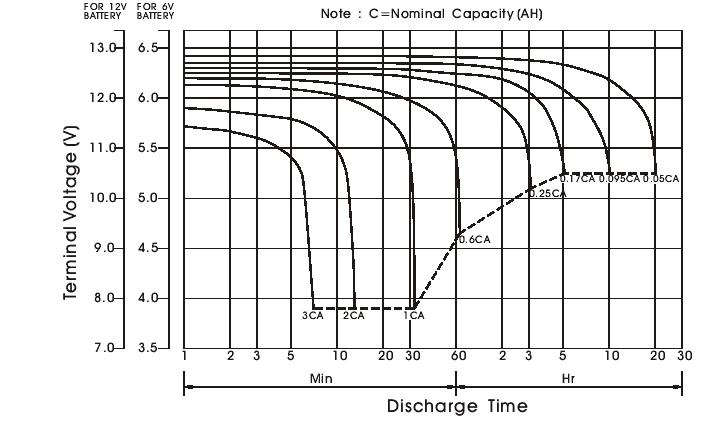Understanding Deep Discharge and Its Impact on Battery Life

Deep discharge refers to discharging a battery to a large extent, typically using 80% or more of its total capacity. Understanding how deep cycle batteries work and how to maintain them for optimal performance is crucial. In this article, we will explore the concept of deep discharge, its impact on battery life and performance, and which battery types are best suited for deep discharge.
Part 1: Understanding Depth of Discharge (DoD)
Depth of Discharge (DoD) is the percentage of a battery’s total capacity that has been used. For example, if a battery has a total capacity of 100 Amp-hours (Ah) and a user has consumed 80 Ah, the DoD is 80%. This metric is crucial for understanding how long rechargeable batteries last and how well they perform.
How to Calculate DoD:
The formula for calculating DoD is straightforward and can be expressed as:
When considering deep discharge, it’s important to also consider the type of battery you’re using. For example, lithium batteries, especially in RV applications, have distinct characteristics when deeply discharged. If you’re planning to install batteries for your RV, you might want to check out a guide to choosing and charging lithium RV batteries to better understand their performance and maintain their lifespan.
State of Charge and Battery Health
Part 5: Deep Discharge Advantages
Batteries designed for deep discharge offer several key advantages:
- Extended Life: These batteries last longer, making them ideal for off-grid applications where charging options are limited.
- Cost-Effective: While their initial cost may be higher, their deep cycle performance means that savings can be realized in the long run by reducing replacement frequency.
- Versatility: Deep cycle batteries can be used in a variety of applications, from recreational vehicles (RVs) to renewable energy systems.
Part 6: Importance of Battery Management System (BMS)
Implementing a Battery Management System (BMS) is crucial for maximizing the lifespan and performance of batteries undergoing deep discharge cycles. A BMS monitors:
- State of Charge (SoC): This indicates how much power is left in the battery.
- Temperature Control: Overheating during charging or discharging can damage the battery.
- Discharge Limits: Preventing discharge beyond recommended levels helps protect the battery from potential damage.
With a BMS, users can easily track the health and performance of their batteries. The BMS alerts users when charging is needed or if issues arise.
Part 7: How to Prevent Deep Discharge
To protect your battery from the detrimental effects of deep discharge, follow these tips:
- Set Discharge Limits: Use systems that automatically cut off power when a specific Depth of Discharge (DoD) is reached to prevent over-discharge and battery damage.
- Regular Maintenance: For flooded lead-acid batteries, maintain proper water levels and clean terminals to ensure good conductivity.
- Monitor Performance: Monitor voltage during use and recharge as soon as necessary. Voltage meters or smart chargers can help you easily track these metrics.
Part 8: Common Applications for Deep Discharge Batteries
Deep discharge batteries are widely used in various industries, including:
- Renewable Energy Systems: Batteries used for solar energy storage must withstand frequent deep discharges without significant degradation.
- Electric Vehicles (EVs): EVs rely on deep cycle batteries to achieve longer driving ranges, minimizing the need for frequent charging.
- Marine Applications: Boats often use deep cycle batteries because they can withstand repeated discharges, providing reliable power for onboard systems like lights and navigation equipment.
Part 9: Frequently Asked Questions (FAQ)
- What is deep discharge?
Deep discharge generally refers to discharging a battery to 80% or more of its total capacity. - Can all batteries handle deep discharge?
Only certain types of batteries, such as deep cycle and lithium-ion batteries, are designed to handle frequent deep discharges without sustaining damage. - How does deep discharge affect battery life?
Frequent deep discharges can significantly shorten a battery’s lifespan by increasing wear and tear on internal components due to chemical reactions within the battery cells. - What should I watch out for when using deep cycle batteries?
Carefully monitor your usage, use a BMS to set appropriate discharge limits, and conduct regular maintenance checks on your battery system. - How can I tell if my battery has been damaged by deep discharge?
Yes, signs of damage include reduced capacity (the battery cannot hold a charge), increased temperature during charging cycles, and physical swelling, especially with lithium-ion batteries.
More Articles
Growth Trends in Flexible Thin-Film and Printed Battery Markets
The flexible thin-film and printed battery market is experiencing rapid growth. This article delves into its expansion, innovations, challenges, and future prospects in this evolving industry.
Battery Charging Cycles: Extending Battery Life and Enhancing Performance
Understand the principles of battery charging cycles and learn related tips and tools, such as battery charging calculators, to extend battery life and improve performance.
Understanding 11.1V Lithium Polymer Batteries: Characteristics, Advantages, and Common Applications
11.1V lithium polymer batteries are widely used in remote control models, drones, and more. In this guide, we will explore their characteristics, advantages, and common applications.
Lithium-Ion Jump Starter vs. Lead-Acid: What’s the Difference?
Lithium-ion jump starters offer a quick and reliable solution for jump-starting car batteries. This comparison highlights the differences between lithium-ion and traditional lead-acid jump starters.
How to Safely Clean Leaked Battery Terminals: A Step-by-Step Guide
This guide details safety tips and methods for cleaning battery leakage from terminals. It helps you understand the risks involved and take appropriate precautions.







